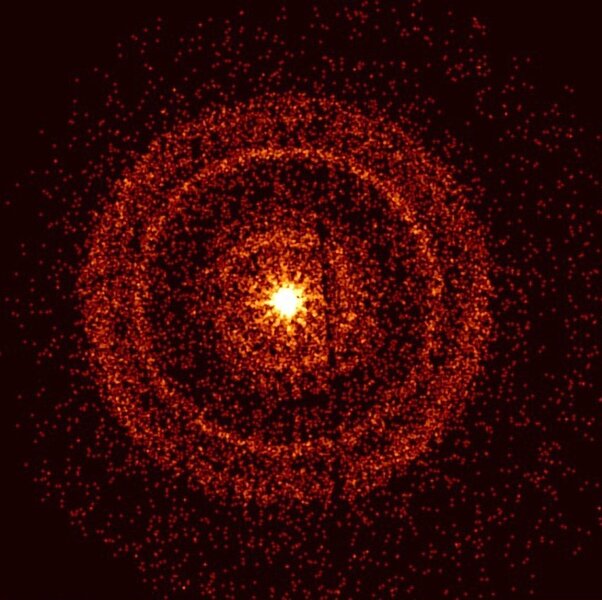Create a free profile to get unlimited access to exclusive videos, sweepstakes, and more!
A dying star produced the most powerful cosmic blast we've ever seen
When massive stars die, they don't go quietly into the night.

In Battlefield Space (now streaming on Peacock!), journalist Tom Costello investigates Space Force, the most recent addition to the U.S. Military. Despite its seemingly grandiose name and space-based operations, Space Force is largely concerned with activities here at home, using space-based assets like satellites. It’s hard not to imagine, however, how the organization might evolve as humanity reaches farther into deep space.
Images of Starfleet, Death Stars, and intrepid individuals defending Earth from alien weapons, are difficult to avoid, and if that ever happens we might be in trouble. Because in the great cosmic arms race, nature has us handily whooped, as evidenced by NASA’s observation of the most powerful gamma ray burst we’ve ever witnessed.
On Oct. 9, a flood of x-rays and gamma rays raced through our solar system where they were picked up by telescopes all over the world and a few off-world. The burst was detected by NASA’s Fermi Gamma-ray Space Telescope, the Neil Gehrels Swift Observatory, and the Wind spacecraft, among others. Once the event was detected, telescopes all around the world turned their sights toward the object to capture the data before it was gone.
That’s the trouble with gamma ray bursts — often abbreviated to GRB — they don’t stick around very long, at least most of the time. GRBs are typically produced in one of two ways. Some are produced by the collision of two neutron stars. Neutron stars are small, but they pack a big punch. They’re only about 20 kilometers in diameter but a teaspoon of neutron star material would have the mass of about a trillion kilograms, that’s roughly the same mass as the entire island of Manhattan, compressed into a teaspoon. When two of them come together, they release about as much energy as the Sun will over the course of its entire lifetime, all at once. These GRBs are incredibly brief, which makes them difficult to detect and measure. The other kind are longer-lived and are the death knell of incredibly massive stars at the end of their lives. That’s the kind scientists think they observed earlier this month.
The burst has been dubbed GRB 221009A, an unassuming name for what appears to have been the most powerful burst of energy we’ve ever seen. The blast came in from the direction of the constellation Sagitta and is estimated to have traveled 1.9 billion years across space to reach us.
For context, when the star that produced GRB 221009A gasped its last breath, the Earth hadn’t yet undergone the Cambrian explosion. Life on our planet consisted of small microbial creatures and cyanobacteria had just gotten started pumping the atmosphere full of oxygen. Every fish that ever swam in the oceans and every creature who ever crawled on land, lived out their lives during the transit time of this massive burst of energy. The star, meanwhile, entered a new stage of being.
Scientists believe the burst marks the birth of a new black hole, which formed when the star collapsed in on itself. In the process, it released 18 teraelectronvolts, completely crushing every GRB record we had established. This is the first GRB we’ve observed which exceeds 10 teraelectronvolts and 221009A nearly doubled that.
The observation is recent, and the data is still being investigated, but it has already helped to progress the science of GRBs. The International Space Station is currently housing two experiments which, when coupled together, make for a powerful GRB observation tool. The first is NASA’s NICER X-ray telescope, and the second is a Japanese detector called MAXI. Together, the two instruments make up the Orbiting High-energy Monitor Alert Network, or OHMAN. As in, “Oh man, there’s something wild happening over there, let’s look at it!”
In essence, MAXI detects bursts of energy in space and NICER then rapidly moves to observe those bursts. Until now, that would have required action by scientists on the ground, but these tools will make the process more efficient. In the future, the OHMAN system could allow for response times of only a few minutes, maximizing the amount of data we’re able to capture from these rare and brief events.
Part of the reason GRB 221009A was so bright and so enduring is because it came from relatively close to us, but that’s about as close as we want a GRB to be. It’s believed that another burst, 450 million years ago, might have triggered the Ordovician extinction which nearly ended life on our planet.



























